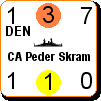delatbabel
Posts: 1252
Joined: 7/30/2006
From: Sydney, Australia
Status: offline

|
quote:
ORIGINAL: AresMars
I am in no way a sailor, I get sea sick in the bath tub.
As do a number of damn fine sailors, until they've been at sea for a few days. :)
quote:
It is a game and thus an abstraction, but that abstraction needs to work in the context of what is trying to be accomplished.
A FLEET counter represents, the ability to project INFLUENCE (perhaps even CONTROL) into an AREA (Sea/Blockade/Port) of the game map.
It represents the Command, Recruitment, Logistical and Supply structure required to control the MOVEMENT _through_ and _around_ a particular sea area and TRADE/Ecomomics through these same areas.
The more fleets available to a country, the more they can project this influence and limit the ability of movement, supply and control/influence of other Naval Powers that may oppose them.
Now you note that GB has the greatest ability to project influence then any other single Naval power. This is the most important play element of Fleets in the EIA NAVAL game. Why you ask?
It took an alliance of two or more Major powers to EQUAL or EXCEED (I would also use compete with here - I'll explain later) the Fleet strenght of England.
This is because Britain had, as a stated and implemented policy during most of this period to (either, it varied over the years):
* Have a fleet strength roughly equal to double the size of the next largest navy; or
* Have a fleet strength roughly equal to the next two largest navies combined.
However in any case I don't accept your analogy. A "fleet" in EiA represents a number of ships. Even a single ship of the line could project a significant amount of naval power -- enough to blockade a small port, fire guns at an unprotected or insufficiently protected harbour sufficient to wreak havoc, or carry and support a small detachment of troops.
The EiA system attempts to portray this by representing both "ships of the line" (as individual ships) and "fleets" as collections of those ships of the line. The original EiA boardgame did away with representing smaller ships -- cutters, sloops, frigates, transports, etc, that would of course accompany any ships of the line (except into battle), and although this has been partially corrected in EiANW it hasn't been done so very well. Ships of the line would rarely engage smaller vessels because it wasn't worth their effort, similarly smaller vessels would rarely engage ships of the line because they couldn't do any serious damage to them -- so in all logical thinking and planning exercises of the period, navies and admirals discussed numbers of ships of the line, because anything less than this (or less than a third rate at least) isn't really of a serious concern.
The combat system in terms of representing "ships" being lost during battles between "fleets" does an OK sort of job, although as someone has pointed out casualties are often not high enough. However the naval movement system doesn't adequately portray the ability of ships to get around from place to place, which is the point I was making.
In terms of the ability to project power -- if the admiralty makes a decision to get Nelson from Copenhagen to Alexandria at the end of June, and Nelson in fact leaves Copenhagen on the 1st June, it should be fundamentally possible to do that (even with corps loaded). Similarly, if the admiralty makes a decision to get Nelson from Copenhagen to Alexandria at the end of January, and Nelson leaves Copenhagen on the 1st January, then he's likely to either sink half way across the North Sea, be blown entirely off course, or get nowhere. Yes, I know that Copenhagen doesn't count as an iced in port in EiA (and it doesn't really ice in every year) but regardless of that prevailing weather conditions aren't going to allow any change in where naval power is being projected during the northern winter. Whereas in the northern summer, given good winds and good enough luck, it's entirely possible.
Examine the 1798 campaign for a few minutes:
* Nelson leaves Gibraltar with 3 ships, 2nd May.
* Brueys leaves Marseilles on the 17th May, and escorts the main (transport) fleet from Toulon leaving on the 19th May. Carries 15,000 men (say 15 factors) and Napoleon.
* Troubridge leaves Gibraltar with 9 ships, 24th May.
* Desaix sails from Italy on the 26th May.
* Nelson and Troubridge meet up in the Gulf of Lyons, 7th June, fail to find the French, and are becalmed north of Corsica until about the 12th June.
* French avoid British south of Candia (Cyprus) on the 27th June, warned of the proximity of the British fleet by an escorting Frigate, 26th June.
* French capture Malta 9th - 19th June.
* 28th June, Nelson arrives in Egypt, finds nothing, sails north.
* French landing in Aboukir Bay, 29th June - 3rd July.
After that the following months events basically see Nelson doing a few laps of the Mediterranean -- he was south of Turkey around the 4th July, went back as far as Sicily during a gale, stayed in Greece until about the 28th July, and then finally returned to Egypt on the 1st August. Obviously his next die roll was a successful intercept, the French failed to evade, and the rest (exploding French flagships included) is history.
quote:
7 MP would allow a GB Fleet sail from Plymouth to the Gulf of Caglari (sea area south of Caglari on Sardinia)
This statement is important for the following two reasons;
a) it takes GB 2 game turns (2 'months') to project influence all the way to the end of the Mediterranean
b) it makes the requirement of Mediterranean PORTS critical to the interests of GB, and that forces GB to worry about Gibraltar (for moving troops into the MED) and Malta (for moving troops further into the MED as well as making sure that fleets can influence all PORTS and COASTAL AREAs) at all times.
However, with the following in mind; In original game, naval movement was like this and there was only one type of ships who took care about fight and transport:
1 fleet - move 7
2 fleets (in same stack) - both move 6
3 fleets (in same stack) - all move 5
4+ fleets (in same stack) - all move 4
if fleet transports a corps: -1 to movement (but all move at least 4)
As I stated earlier, not at all realistic (and in any case this was an optional rule). In any case, why does one fleet of 20 ships of the line move slower than 2 fleets each carrying 10 ships of the line?
_____________________________
--
Del
|
 Printable Version
Printable Version








 New Messages
New Messages No New Messages
No New Messages Hot Topic w/ New Messages
Hot Topic w/ New Messages Hot Topic w/o New Messages
Hot Topic w/o New Messages Locked w/ New Messages
Locked w/ New Messages Locked w/o New Messages
Locked w/o New Messages Post New Thread
Post New Thread